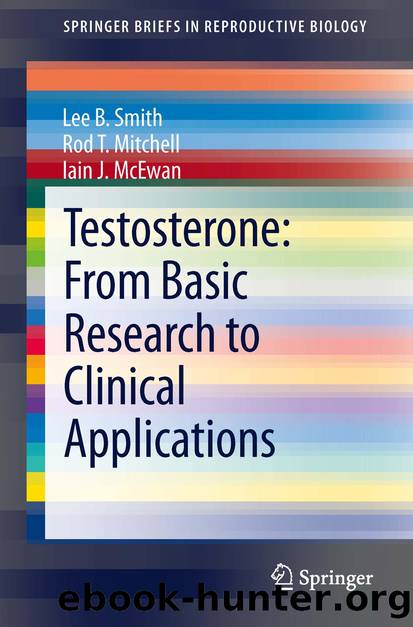Testosterone: From Basic Research to Clinical Applications by Lee B. Smith Rod T. Mitchell & Iain J. McEwan

Author:Lee B. Smith, Rod T. Mitchell & Iain J. McEwan
Language: eng
Format: epub
Publisher: Springer New York, New York, NY
5.3 Prostate
5.3.1 Androgens and Prostate Gland Development
The prostate gland surrounds the urethra as it emerges from the bladder and in humans described as being the size and shape of a walnut (Marker et al. 2003) (Fig. 5.1). Androgenic hormones are important for both prostate development and function in adult life. The prostate contributes secreted proteins and nutrients to the seminal fluid and is therefore important for sperm viability (Marker et al. 2003). The prostate arises from the urogenital sinus at around 10–12 weeks in humans and 17.5 dpc in the mouse in response to circulating androgens. In mice and rats the branching of the prostatic ducts occurs after birth giving rise to three lobes: the anterior prostate, the dorsolateral prostate, and the ventral prostate (Marker et al. 2003). The prostate in humans although lacking a lobular morphology can be described in terms of three distinct regions: the central, transitional, and peripheral zones.
Prostatic ducts are made up of luminal secretory epithelial cells, basal epithelial cells, and stromal smooth muscle cells (Marker et al. 2003; Oldridge et al. 2012). In addition embedded within the epithelial compartment are stem cells and neuroendocrine cells (Marker et al. 2003; Oldridge et al. 2012). The importance of androgens and AR for the fetal development of the gland is clearly demonstrated by the absence of a prostate in mice and human patients lacking a functional AR (Marker et al. 2003 and references therein). Prostate development requires metabolism of testosterone to DHT by 5α−reductase type 2, which acts as the local mediator of androgen action. The AR is highly expressed in the luminal epithelial cells and is also found in the cells of the stromal compartment, but there is little or no expression in the basal cells and none in prostate stem cells (Fig. 5.2a) (Oldridge et al. 2012). In utero the mesenchymal AR is important for ductal morphogenesis, which involves paracrine signaling, while the epithelial AR is involved in the secretory function of the gland. Thus, both direct and indirect AR actions combine to determine prostate identity. A number of developmentally regulated genes have been identified in prostate development and key mediators of androgen action are sonic hedgehog (Shh) and the homeobox transcription factor Nkx 3.1, which are both AR-regulated (Marker et al. 2003).
Fig. 5.2Androgen receptor in normal and prostate cancer cells. a Schematic illustration showing the morphology of the normal prostate (Top) and the levels of androgen receptor (AR) in different cell types. The AR in stromal cells acting through paracrine factors stimulates proliferation and cell survival of epithelial cells; while the epithelial AR inhibits proliferation and promotes differentiation and regulates protein synthesis and secretion. Prostate cancer development involves multiple genetic changes, indicated by the arrows, including the loss of tumor suppressor gens NKx3.1, PTEN, and Rb; the early stages are thought to be characterized by development of prostatic intraepithelial neoplasia (PIN). Treatment of metastatic disease involves blocking testosterone production and AR signaling (androgen ablation therapy). However, resistance to therapy results in castrate-resistant prostate cancer (CRPC),
Download
This site does not store any files on its server. We only index and link to content provided by other sites. Please contact the content providers to delete copyright contents if any and email us, we'll remove relevant links or contents immediately.
Men In Love by Nancy Friday(4978)
Everything Happens for a Reason by Kate Bowler(4487)
The Immortal Life of Henrietta Lacks by Rebecca Skloot(4271)
Why We Sleep by Matthew Walker(4202)
The Sports Rules Book by Human Kinetics(4087)
Not a Diet Book by James Smith(3162)
The Emperor of All Maladies: A Biography of Cancer by Siddhartha Mukherjee(2941)
Sapiens and Homo Deus by Yuval Noah Harari(2858)
Day by Elie Wiesel(2603)
Angels in America by Tony Kushner(2399)
Endless Forms Most Beautiful by Sean B. Carroll(2358)
A Burst of Light by Audre Lorde(2355)
Hashimoto's Protocol by Izabella Wentz PharmD(2210)
Dirty Genes by Ben Lynch(2171)
Reservoir 13 by Jon McGregor(2152)
And the Band Played On by Randy Shilts(2023)
Wonder by R J Palacio(2000)
The Immune System Recovery Plan by Susan Blum(1974)
Stretching to Stay Young by Jessica Matthews(1951)
